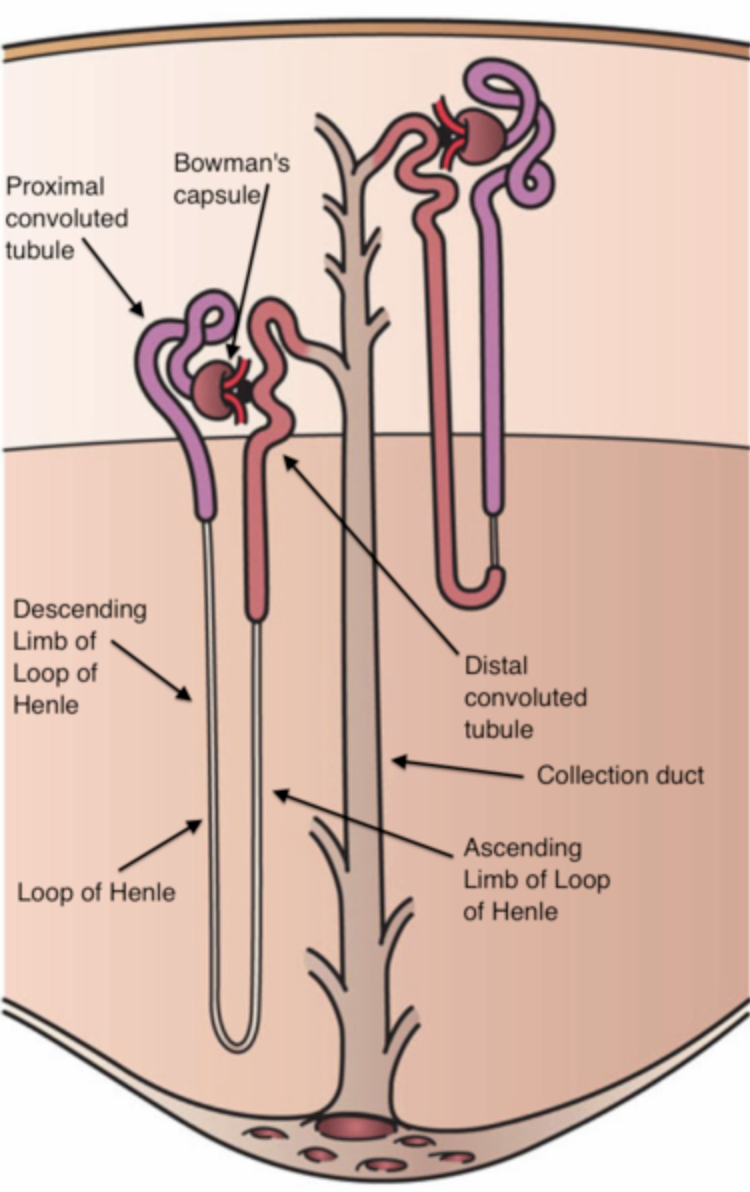
An adaptation in the structure and function of loop of Henle to the xerophytic environment is:
(a) A short loop of Henle, which allows more filtrate to be removed from the blood
(b) A short loop of Henle, which allows less water to be removed from the filtrate
(c) A long loop of Henle, which allows more filtrate to be removed from the blood
(d) A long loop of Henle, which allows more water to be removed from the filtrate
(e) A long loop of Henle, which allows less filtrate to be removed from the blood
Answer
558.3k+ views
Hint: It is a long U-shaped portion of the tubule that conducts urine within each nephron of the kidney of reptiles, birds, and mammals. This function allows the assembly of urine that's much more concentrated than blood, limiting the quantity of water needed as an intake for survival.
Complete answer:
A variation inside the structure and execution of the loop of Henle to the xerophytic climate is that they need a truly long loop of Henle, which permits more water to be removed from the filtrate. The climate in these regions is dry and hot. The main function of the loop of Henle shows to be the recovery of water and common salt from the urine.

The fluid entering the loop is the arrangement of salt, urea, and different substances passed along by the proximal convoluted tubule, from which the greater part of the broken down segments required by the body. Especially glucose, amino acids, and sodium bicarbonate have been reabsorbed into the blood. Many species that sleep in arid environments like deserts have highly efficient loops of Henle.
Additional information: The fluid entering the loop of Henle is that the arrangement of salt, urea, and different substances passed along by the proximal convoluted tubule, from which a large portion of the broke down segments required by the body—especially glucose, amino acids, and sodium bicarbonate—have been reabsorbed into the blood.
So the correct answer is ‘(d) A long loop of Henle, which allows more water to be removed from the filtrate’.
Note: During a healthy person the reabsorption of salt from the urine exactly maintains the bodily requirement: during times of low salt intake virtually none is allowed to flee in the urine, although in the duration of high salt intake the excess is excreted.
Complete answer:
A variation inside the structure and execution of the loop of Henle to the xerophytic climate is that they need a truly long loop of Henle, which permits more water to be removed from the filtrate. The climate in these regions is dry and hot. The main function of the loop of Henle shows to be the recovery of water and common salt from the urine.

The fluid entering the loop is the arrangement of salt, urea, and different substances passed along by the proximal convoluted tubule, from which the greater part of the broken down segments required by the body. Especially glucose, amino acids, and sodium bicarbonate have been reabsorbed into the blood. Many species that sleep in arid environments like deserts have highly efficient loops of Henle.
Additional information: The fluid entering the loop of Henle is that the arrangement of salt, urea, and different substances passed along by the proximal convoluted tubule, from which a large portion of the broke down segments required by the body—especially glucose, amino acids, and sodium bicarbonate—have been reabsorbed into the blood.
So the correct answer is ‘(d) A long loop of Henle, which allows more water to be removed from the filtrate’.
Note: During a healthy person the reabsorption of salt from the urine exactly maintains the bodily requirement: during times of low salt intake virtually none is allowed to flee in the urine, although in the duration of high salt intake the excess is excreted.
Recently Updated Pages
Master Class 12 Economics: Engaging Questions & Answers for Success

Master Class 12 Maths: Engaging Questions & Answers for Success

Master Class 12 Biology: Engaging Questions & Answers for Success

Master Class 12 Physics: Engaging Questions & Answers for Success

Master Class 8 Maths: Engaging Questions & Answers for Success

Class 8 Question and Answer - Your Ultimate Solutions Guide

Trending doubts
What is meant by exothermic and endothermic reactions class 11 chemistry CBSE

Which animal has three hearts class 11 biology CBSE

10 examples of friction in our daily life

One Metric ton is equal to kg A 10000 B 1000 C 100 class 11 physics CBSE

1 Quintal is equal to a 110 kg b 10 kg c 100kg d 1000 class 11 physics CBSE

Difference Between Prokaryotic Cells and Eukaryotic Cells




